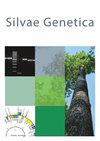探索塞浦路斯橡树的基因库:没有交叉杂交的证据
IF 1
4区 农林科学
Q3 FORESTRY
引用次数: 0
摘要
摘要在本研究中,我们对塞浦路斯所有三种本土橡树进行了群体遗传分析,并探讨了两个中间个体是否来自于栓皮栎(Quercus coccifera ssp.)之间的交叉杂交。卡利普里诺菌和感染菌。veneris。为此,我们成功地测试了最初为其他橡树物种开发的叶绿体和核微卫星。我们找到了一套可以有效地用于物种鉴定和杂交研究的标记。基于叶绿体微卫星的单倍型可以分辨不同的母系,并能区分研究区所代表的两个区段。利用核微卫星,我们描述了物种间遗传多样性的模式,地方性的桤木表现出遗传多样性的降低。此外,我们采用了多变量分析,可以清楚地区分三个物种。2个中间个体聚集在侵染菌点云内。并且还具有该物种典型的叶绿体单倍型。因此,我们拒绝了交叉杂交的假设,并将其表型出现解释为Q. infetoria ssp内高表型可塑性的结果。veneris。本文章由计算机程序翻译,如有差异,请以英文原文为准。
Exploring the gene pools of Cypriot oaks: no evidence of intersectional hybridization
Abstract In our study, we performed a population genetic analysis in all three native oak species of Cyprus and addressed whether two intermediate individuals arose from intersectional hybridization between Quercus coccifera ssp. calliprinos and Q. infectoria ssp. veneris. For this purpose, we successfully tested chloroplast and nuclear microsatellites initially developed for other oak species. We identified a set of markers that can be efficiently used for species identification and study of hybridization. Haplotypes based on the chloroplast microsatellites could resolve different maternal lineages and distinguish between the two sections represented in the study area. Using the nuclear microsatellites, we described patterns of genetic diversity across species with the endemic Q. alnifolia exhibiting reduced genetic diversity. Additionally, we employed a multivariate analysis, which could clearly differentiate among the three species. The two intermediate individuals clustered within the point cloud of Q. infectoria ssp. veneris and also possessed a chloroplast haplotype typical for this species. Therefore, we rejected the hypothesis of intersectional hybridization and interpreted their phenotypic appearance as the result of high phenotypic plasticity within Q. infectoria ssp. veneris.
求助全文
通过发布文献求助,成功后即可免费获取论文全文。
去求助
来源期刊

Silvae Genetica
农林科学-林学
CiteScore
2.20
自引率
10.00%
发文量
10
审稿时长
3 months
期刊介绍:
Silvae Genetica is an international peer reviewed journal with more than 65 year tradition and experience in all fields of theoretical and applied Forest Genetics and Tree breeding. It continues "Zeitschrift für Forstgenetik und Forstpflanzenzüchtung" (Journal of Forest Genetics and Forest Tree Breeding) founded by W. LANGNER in 1951.
 求助内容:
求助内容: 应助结果提醒方式:
应助结果提醒方式:


